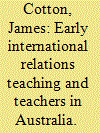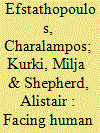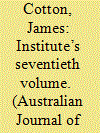|
|
|
Sort Order |
|
|
|
Items / Page
|
|
|
|
|
|
|
| Srl | Item |
| 1 |
ID:
119070


|
|
|
|
|
| Publication |
2013.
|
| Summary/Abstract |
This article is a contribution to the re-evaluation of the formative years of the emergent international relations discipline. Work on this topic, extensive over the past decade and a half, has overturned a number of the foundational myths of the global discipline, especially regarding the period between the two world wars. The literature on international relations in Australia, slow to reflect this re-evaluation, generally still locates the first important developments in the 1960s, and characterises the scholarship that emerged as predominantly 'realist'. This study both pushes back the boundaries and challenges the theoretical perspectives used to categorise thinking in Australia at that time. A student of C. A. W. Manning and thus conversant with British ideas of 'international society', George Modelski's early exposure to theoretical work in the USA and his endeavours to give his department a strongly regional focus gave his work a richness and multifaceted character not easily captured by the 'realist-rationalist' dichotomy. Modelski went on from the Australian National University to become a major figure in international relations in the USA, contributing to the original debates on globalisation and best known for his work on 'long cycles' in world politics.
|
|
|
|
|
|
|
|
|
|
|
|
|
|
|
|
| 2 |
ID:
119069


|
|
|
|
|
| Publication |
2013.
|
| Summary/Abstract |
Drawing on the insights of the current literature concerned with the institutions which fostered and supported the emergence of the international relations (IR) discipline, this article reassesses the Australian contribution in the interwar years. From this period, teaching materials and surviving lecture notes, as well as documentation of Australian participation in the International Studies Conference, show that, contrary to the received view, academies and institutions supported a recognisable IR, albeit in its formative stages. Even by the early 1920s there was a developing awareness that 'international relations' was a discrete subject worthy of presentation in a specific curriculum. The Melbourne school initiated by William Harrison Moore exerted the greatest influence; an energetic pioneering effort in Sydney under H. Duncan Hall was not maintained after his departure. Law and history departments offered such courses, though their place in wider programs depended upon the contingencies of personalities and appointments. By the 1930s, IR teachers were familiar with the major methodological debates of the era in the UK and the USA. While consistent attention was devoted to international organisation, and 'collective security' had its champions, the predominant view, in the terminology of the 'first debate', was neither idealist nor realist.
|
|
|
|
|
|
|
|
|
|
|
|
|
|
|
|
| 3 |
ID:
175164


|
|
|
|
|
| Summary/Abstract |
Communities on the planet are faced with complex challenges: changing relations within and between human communities, changing relations with ecological and climatic conditions, and shifts in technology-human interconnections. The complex interconnections across issue areas – migration, environmental degradation and new technologies, for example – demand that scholars increasingly think across theories, paradigms, specialisms and disciplines. But how should we ‘hold things together’ as we try to make sense of complex realities in International Relations (IR)? This introductory article to the Special Issue ‘Facing human interconnections: thinking International Relations into the future’ discusses the open thematic of ‘human interconnections’ that is used to loosely structure the contributions. Analysis of human interconnections, as understood here, does not have a precise or fixed definition but is considered an open-ended notion with varied meanings and dimensions. Indeed, the authors engage it here in varied ways to explore their empirical, theoretical and political concerns. Yet, this notion also allows for interesting new questions to be posed on the potential and limits of IR as it faces the future, and debates around how we see interconnections between issue areas and ‘-isms’, how IR constructs ‘humans’ or ‘non-humans’ in interconnections, and what is at stake in bringing to our attention unacknowledged interconnections. Here we set out why human interconnection is an interesting notion to work with and why we need to keep its meaning open-ended. We also provide an account of six different orientations we observe amongst the authors tackling the dynamics of human interconnections in this Special Issue.
|
|
|
|
|
|
|
|
|
|
|
|
|
|
|
|
| 4 |
ID:
146525


|
|
|
|
|
| Summary/Abstract |
Australian Outlook, published initially in 1947, was Australia’s first journal devoted exclusively to the analysis of Australia’s foreign relations and of international affairs. It emerged from a context where nationalist and internationalist sentiments were taking on new prominence and in a time of heightened public awareness of global issues. The journal came to provide a unique venue for academic and expert commentary, especially on the international politics of Australia’s region, as well as on a wide range of topics from defence and trade to great-power dynamics. Early contributions demonstrated a generally sound—and sometimes remarkably prescient—grasp of regional and international trends. The journal built on earlier Australian Institute of International Affairs publications—notably, the Austral-Asiatic Bulletin, inaugurated in 1937.
|
|
|
|
|
|
|
|
|
|
|
|
|
|
|
|
| 5 |
ID:
140876


|
|
|
|
|
| Summary/Abstract |
Scholars of international relations (IR) simultaneously believe that their work is policy-relevant and that a gap exists between the academic and policy worlds of IR. Using data from the 2011 Teaching, Research, and International Policy (TRIP) survey and the TRIP journal article database, we explore this disjuncture in one specific area, research on East Asia. If US scholars' work addresses policy-relevant issues, as they believe, we would expect academic work to provide insights on a region that US policy makers have long thought to be growing in strategic importance. We find that academics recognize the strategic significance of East Asia, but comparatively few scholars teach about or do research on the region. Compared with the IR discipline more broadly, published research on East Asia is more paradigmatic, qualitative, and oriented toward the study of international political economy. The neglect of East Asia and the systematic differences in the way it is studied have potentially important consequences for the study and practice of IR.
|
|
|
|
|
|
|
|
|
|
|
|
|
|
|
|
|
|
|
|
|